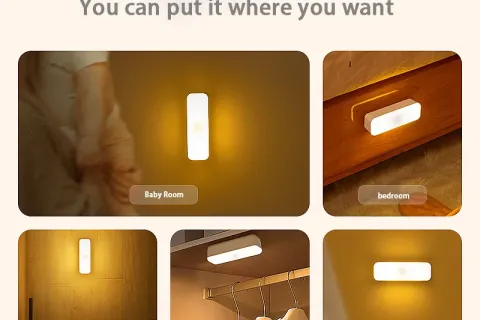If your motion sensor night light indoor suddenly goes completely out, the most common cause of failure is usually the power supply. Whether battery-powered or plugged in, if the power supply cannot provide sufficient voltage, the system will not function properly.
Factors that can interfere with motion sensor night lights: 1. Temperature fluctuations and heat sources 2. Air flow and swaying curtains 3. Electromagnetic interference 4. Light fluctuations 5. Sensitivity setting issues 6. Humidity and moisture 7. Animal interference
• 3-6 months: The need for a nursery night lamp gradually emerges, and it can be used appropriately. • 6 months to 1 year: The nursery night lamp's soothing effect is significant and its value is greatest. • After one year old: A nightlight becomes an important aid for psychological comfort and sleep development.
• Standard household lighting: Living rooms or study rooms typically have 200-500 lux. • Nightlighting in a baby's bedroom: 5-20 lux is recommended. This brightness range satisfies parents' basic care needs without overstimulating the baby. In other words, the brightness of a nursery night light should approach the soft effect of moonlight.
Preschoolers aged 3–6: A low-brightness, warm-light LED night light can help with sleep, but it's best to set it to automatically turn off. School-age children aged 6 and older: Most children no longer need a night light on all night and should gradually adjust to natural darkness.
The core functionality of a motion sensor night light relies on its sensor to detect changes in the surrounding environment. When users cover the sensor with tape, they are effectively limiting its sensing range, preventing it from detecting motion signals.
A cat's body temperature is similar to that of a human, and their movements generate certain heat fluctuations. Infrared sensors rely on heat fluctuations to activate the light, so in theory, cat activity could activate these sensors.
Many motion sensor night lights allow the user to adjust the sensitivity. If the sensor sensitivity is set too high, it may detect minor environmental changes or motion far away from the light fixture. This is particularly noticeable in large spaces or when the light fixture is improperly positioned.
Whether an LED night light requires a plug-in depends on the type. Plug-in LED night lights obviously require a plug-in to operate. Battery-powered and USB-rechargeable LED night lights, on the other hand, do not require a plug-in.
Adhesive mounting is another very convenient installation method. Most motion sensor night lights come with strong adhesive or 3M tape. Users can simply apply the adhesive to the wall, furniture, or door frame, and then secure the night light to the adhesive.
When users find that their RGB LED night lights don't change color, the problem usually lies with the light source chip, circuit driver, control signal, or usage environment. Common causes include: 1. Damage to a specific color chip; 2. Driver circuit failure; 3. Failure to transmit signals from the remote control or app; 4. Circuit abnormalities caused by external factors.
According to manufacturers, many battery-powered motion sensor night lights can last approximately 30 days under normal use. However, this duration varies and can be affected by several factors.












